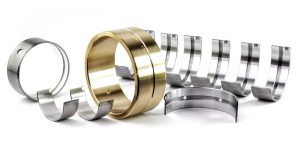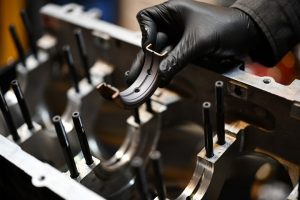Engine bearings play a crucial but often overlooked role in the smooth and efficient operation of your vehicle’s engine. These small yet vital components enable the engine’s moving parts to operate with minimal friction and wear, ensuring longevity and performance. Understanding the different types of engine bearings — main, rod, and thrust bearings — is essential for mechanics, car enthusiasts, and anyone interested in how an engine works.
In this article, we will demystify engine bearings by exploring their functions, differences, wear symptoms, and maintenance tips. Whether you’re diagnosing engine issues or planning repairs, knowing about these bearings can save you time and money.
What Are Engine Bearings?

Engine bearings are specially designed components that support rotating parts of the engine, mainly the crankshaft and connecting rods. They allow these parts to move smoothly within tight clearances, reducing friction and preventing metal-to-metal contact. Bearings also help absorb and distribute loads caused by engine forces, preventing damage to expensive components.
Types of Engine Bearings
There are three primary types of engine bearings:
| Bearing Type | Location | Function |
|---|---|---|
| Main Bearings | Between engine block and crankshaft | Support the crankshaft in the engine block, allowing it to rotate freely |
| Rod Bearings | Between connecting rods and crankshaft journals | Allow the connecting rods to pivot smoothly as the pistons move |
| Thrust Bearings | On the crankshaft flange(s) | Control axial (end-to-end) movement of the crankshaft |
Main Bearings
Function:
Main bearings support the crankshaft inside the engine block, holding it in place while it rotates. They carry the radial loads (forces perpendicular to the crankshaft’s axis) generated by combustion and inertia.
Structure:
Main bearings typically consist of two halves: one installed in the engine block and the other attached to the main bearing cap. Together, they form a smooth surface with a precise clearance for the crankshaft journals.
Common Issues:
-
Bearing wear or scoring due to lubrication failure
-
Excessive clearance causing crankshaft knock
-
Overheating from oil starvation
Rod Bearings
Function:
Rod bearings are located where the connecting rods attach to the crankshaft journals. They enable the rods to pivot smoothly during the piston’s up-and-down movement, handling both radial and slight axial loads.
Structure:
Similar to main bearings, rod bearings come in two halves that clamp around the crankshaft journals, providing a smooth and low-friction interface.
Common Issues:
-
Rapid wear caused by dirty or low-quality oil
-
Bearing failure from excessive engine loads or overheating
-
Uneven wear leading to piston slap or knocking sounds
Thrust Bearings
Function:
Thrust bearings control the axial movement of the crankshaft—that is, preventing it from moving forward and backward inside the engine block beyond a safe limit. This axial control is vital for proper timing and to avoid damage to the engine components.
Structure:
Usually found near the middle main bearing, thrust bearings have flanged surfaces designed to absorb axial forces.
Common Issues:
-
Excessive axial play causing endplay in the crankshaft
-
Premature wear from misalignment or lack of lubrication
-
Increased noise and vibration due to crankshaft movement
Engine Bearing Materials
Engine bearings are made from specialized materials that balance durability, friction reduction, and load handling.
| Material Type | Characteristics | Common Use |
|---|---|---|
| Babbitt (White Metal) | Soft, conformable, good embedability | Classic engines, older designs |
| Copper-Lead | Excellent load capacity, good fatigue resistance | Performance engines, heavy-duty use |
| Tri-metal (Steel Backed) | Steel backing with layers of copper, lead, and tin | Most modern engines |
| Aluminum Alloys | Lightweight, good thermal conductivity | Some racing or light engines |
Signs of Engine Bearing Wear
Early detection of bearing wear can prevent costly engine damage. Watch for these symptoms:
-
Knocking or tapping noise: Often called “rod knock,” indicates rod bearing wear.
-
Low oil pressure: Bearing clearance increases, reducing oil pressure.
-
Metal shavings in oil: Indicates bearing or other engine parts are deteriorating.
-
Excessive crankshaft endplay: Points to thrust bearing wear.
-
Overheating engine: Friction from worn bearings generates excessive heat.
Diagnosing Engine Bearing Problems
| Diagnostic Method | What to Check | Notes |
|---|---|---|
| Visual inspection | Bearing surface condition | Remove caps, look for scoring, pitting |
| Measuring bearing clearance | Use plastigauge or micrometer | Compare against manufacturer specs |
| Oil pressure test | Measure oil pressure at idle and RPM | Low pressure suggests bearing clearance issues |
| Noise diagnosis | Listen for knocking under load | Rod knock is classic symptom |
Maintenance Tips to Prolong Bearing Life
-
Regular oil changes: Clean oil prevents abrasive wear and overheating.
-
Use quality oil and filters: Ensure proper lubrication under all conditions.
-
Avoid engine overload: Hard acceleration or towing can strain bearings.
-
Monitor engine temperature: Overheating can cause bearing damage.
-
Inspect and replace bearings during rebuilds: Never reuse worn bearings.
Replacement and Repair

Engine bearings are wear items that require replacement during engine rebuilds or when wear symptoms arise. Proper installation is crucial—clearance must be checked precisely, and components cleaned thoroughly.
Cost Considerations:
| Item | Estimated Cost Range (USD) |
|---|---|
| Main bearing set | $50 – $150 |
| Rod bearing set | $40 – $120 |
| Thrust bearings | $20 – $60 |
| Labor (engine rebuild) | $500 – $1500+ (varies widely) |
For high-quality, reliable engine bearings that meet OEM specifications, visit Buy Engine Bearings online.
Summary Table: Engine Bearings Overview
| Bearing Type | Location | Primary Function | Common Failure Signs | Replacement Interval |
|---|---|---|---|---|
| Main Bearings | Engine block/crankshaft | Support crankshaft rotation | Knocking noise, low oil pressure | Engine rebuild or wear detected |
| Rod Bearings | Connecting rods/journals | Enable piston movement | Rod knock, metal particles in oil | Engine rebuild or damage |
| Thrust Bearings | Crankshaft flange | Control crankshaft endplay | Excessive crankshaft play, noise | Engine rebuild or wear |
Final Thoughts
Engine bearings might be small and hidden deep inside your engine, but their importance cannot be overstated. They ensure that your engine’s moving parts work harmoniously, reducing friction and wear while supporting vital components like the crankshaft and connecting rods. Understanding main, rod, and thrust bearings helps you diagnose engine noises, prevent damage, and maintain optimal engine performance.
Always use high-quality bearings that meet your vehicle’s specifications and consult professional mechanics for installation and inspections. For trusted parts and competitive prices, remember to Buy Engine Bearings online and keep your engine running smoothly for miles to come.